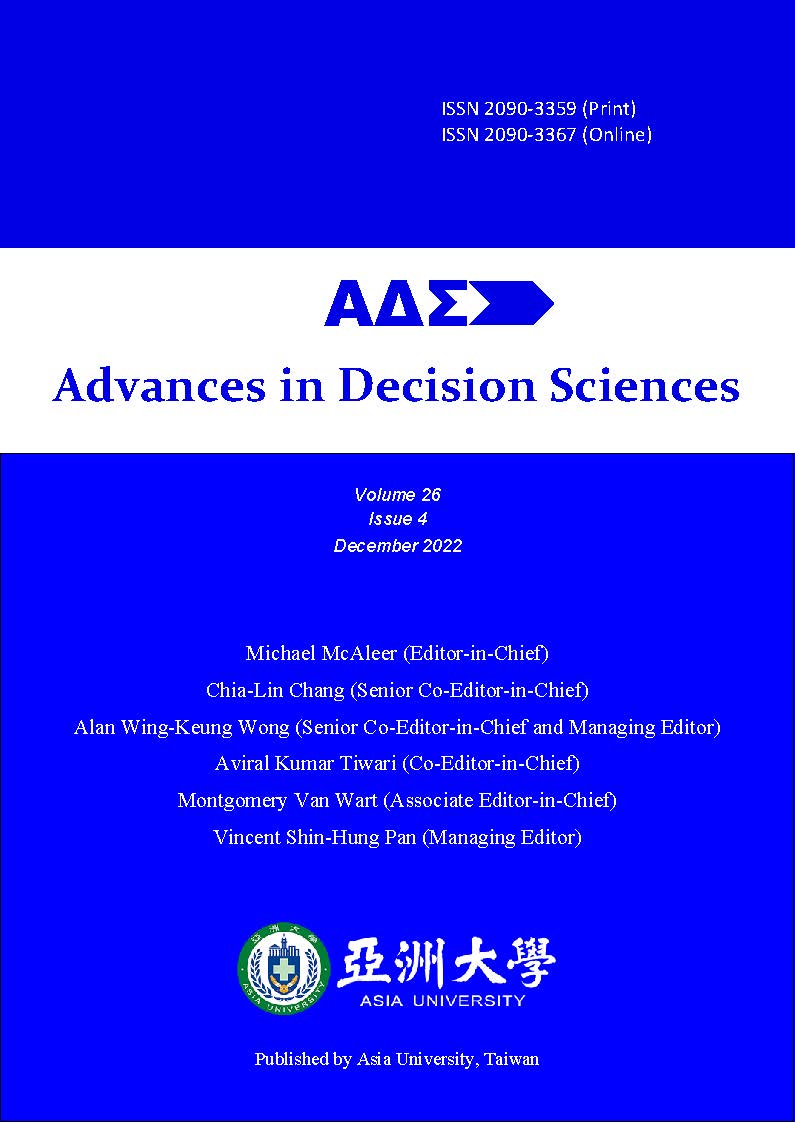Discussing Applications in Sciences in the prevention of COVID-19*
DOI:
https://doi.org/10.47654/v26y2022i4p1-16Keywords:
Discussion, Applications, Decision Sciences, COVID-19Abstract
Purpose: The main purpose of this work is to provide an overview of the COVID-19 issue, this article discusses in detail and fully the important and meaningful applications of Decision Sciences to the prevention of COVID-19. Because COVID-19 is an extremely hot topic and the most fascinating question in recent years, the research on this topic is very interesting and noticed by scientists.
Design/methodology/approach: In the scope of this study, we first introduce definitions and issues related to COVID-19 and study the negative impacts of COVID-19 diseases on all sectors of society. We then provide a comprehensive introduction to the applied aspects of Decision Science in the prevention of COVID-19.
Findings: The findings of our research help people have a correct, complete, overview, and comprehensive view of the COVID-19 issue. All COVID-19 issues are discussed in great detail and completeness in this article.
Originality/value: All the issues discussed in this study are original and new in the literary literature.
Practical implications: This will help the countries’ leaders have the best way to fight the COVID-19 pandemic more effectively and cost-effectively.
References
Abd Elaziz, M., AA Al-qaness, M., Abo Zaid, E. O., Lu, S., Ali Ibrahim, R., and A. Ewees, A. (2021), Automatic clustering method to segment COVID-19 CT images, PloS one, 16(1), e0244416.
Alakus, T. B., and Turkoglu, I. (2020), Comparison of deep learning approaches to predict COVID-19 infection, Chaos, Solitons and Fractals, 140, 110120.
Ali, S., Naveed, M., Saleem, A., & Nasir, M. W. (2022). Time-frequency co-movement between COVID-19 and Pakistan’s Stock Market: Empirical evidence from wavelet coherence analysis. Annals of Financial Economics, 2250026.
Allen, D. E., and McAleer, M. (2021), Predicting COVID-19 cases and deaths in the USA from tests and state populations, Advances in Decision Sciences, 25(2), 1-27.
Azarafza, M., Azarafza, M., and Akgun, H. (2020), Clustering method for spread pattern analysis of corona-virus (COVID-19) infection in Iran, medRxiv.
Bai, Z., Wong, W. K., & Zhang, B. (2010). Multivariate linear and nonlinear causality tests. Mathematics and Computers in simulation, 81(1), 5-17.
Belete, T. M. (2021), Review on up-to-date status of candidate vaccines for COVID-19 disease, Infection and drug resistance, 14, 151.
Burki, T. K. (2022). Omicron variant and booster COVID-19 vaccines. The Lancet Respiratory Medicine, 10(2), e17.
Chang, C. L., McAleer, M., & Wong, W. K. (2020). Risk and financial management of COVID-19 in business, economics and finance. Journal of Risk and Financial Management, 13(5), 102.
Chen, Y., Xu, Z., Wang, P., Li, X. M., Shuai, Z. W., Ye, D. Q., & Pan, H. F. (2022). New-onset autoimmune phenomena post-COVID-19 vaccination. Immunology, 165(4), 386-401.
Chu, A. M., Chan, T. W., So, M. K., & Wong, W. K. (2021). Dynamic network analysis of COVID-19 with a latent pandemic space model. International Journal of Environmental Research and Public Health, 18(6), 3195.
Daniel, J. (2020), Education and the COVID-19 pandemic, Prospects, 49(1), 91-96.
Duong, K. D., Nguyen, Q. N., Le, T. V., & Nguyen, D. V. (2021). Limit-to-arbitrage factors and ivol returns puzzle: Empirical evidence from Taiwan before and during COVID-19. Annals of Financial Economics, 16(01), 2150004.
Gasbarro, D., Wong, W. K., & Kenton Zumwalt, J. (2007). Stochastic dominance analysis of iShares. The European Journal of Finance, 13(1), 89-101.
Kashte, S., Gulbake, A., El-Amin III, S. F., and Gupta, A. (2021), COVID-19 vaccines: rapid development, implications, challenges and future prospects, Human cell, 1-23.
Kawohl, W., and Nordt, C. (2020), COVID-19, unemployment, and suicide, The Lancet Psychiatry, 7(5), 389-390.
Kheni, S., & Kumar, S. (2021). Cases, deaths, stringency indexes and Indian financial market—empirical evidence during Covid-19 pandemic. Annals of Financial Economics, 16(02), 2150009.
Koff, W. C., Schenkelberg, T., Williams, T., Baric, R. S., McDermott, A., Cameron, C. M., ... and Goudsmit, J. (2021), Development and deployment of COVID-19 vaccines for those most vulnerable, Science translational medicine, 13(579), eabd1525.
Lv, Z., Chu, A. M., Wong, W. K., & Chiang, T. C. (2021). The maximum-return-and-minimum-volatility effect: evidence from choosing risky and riskless assets to form a portfolio. Risk Management, 23(1), 97-122.
Ma, C., & Wang, X. (2021). Strategic interactions and negative oil prices. Annals of Financial Economics, 16(03), 2150013.
Mahmoudi, M. R., Baleanu, D., Mansor, Z., Tuan, B. A., and Pho, K. H. (2020), Fuzzy clustering method to compare the spread rate of Covid-19 in the high risks countries, Chaos, Solitons and Fractals, 140, 110230.
Maleki, M., Mahmoudi, M. R., Heydari, M. H., and Pho, K. H. (2020a), Modeling and forecasting the spread and death rate of coronavirus (COVID-19) in the world using time series models, Chaos, Solitons and Fractals, 140, 110151.
Maleki, M., Mahmoudi, M. R., Wraith, D., and Pho, K. H. (2020b), Time series modelling to forecast the confirmed and recovered cases of COVID-19, Travel medicine and infectious disease, 37, 101742.
McAleer, M. (2021a), A critique of recent medical research in JAMA on COVID-19, Advances in Decision Sciences, 25(1), 1-102.
McAleer, M. (2021b), Critical Analysis of Some Recent Medical Research in Science on COVID-19, Advances in Decision Sciences, 25(1), 1-41.
McGarry, B. E., Barnett, M. L., Grabowski, D. C., & Gandhi, A. D. (2022). Nursing home staff vaccination and COVID-19 outcomes. New England Journal of Medicine, 386(4), 397-398.
Pho, K. H. (2022a). Goodness of fit test for a zero-inflated Bernoulli regression model. Communications in Statistics-Simulation and Computation, 1-16.
Pho, K. H. (2022b). Improvements of the Newton–Raphson method. Journal of Computational and Applied Mathematics, 408, 114106.
Shiba, S., & Gupta, R. (2021). Uncertainty related to infectious diseases and forecastability of the realized volatility of us treasury securities. Annals of Financial Economics, 16(02), 2150008.
Sinha, I. P., Harwood, R., Semple, M. G., Hawcutt, D. B., Thursfield, R., Narayan, O., ... and Southern, K. W. (2020), COVID-19 infection in children, The Lancet Respiratory Medicine, 8(5), 446-447.
Rosenberg, E. S., Dorabawila, V., Easton, D., Bauer, U. E., Kumar, J., Hoen, R., ... & Zucker, H. A. (2022). Covid-19 vaccine effectiveness in New York state. New England Journal of Medicine, 386(2), 116-127.
Safi, S. K., Sanusi, O. I., & Tabash, M. I. (2022). Forecasting the Impact of COVID-19 Epidemic on China Exports using Different Time Series Models. Advances in Decision Sciences, 26(1), 1-25.
Su, Y., Yuan, D., Chen, D. G., Ng, R. H., Wang, K., Choi, J., ... & Heath, J. R. (2022). Multiple early factors anticipate post-acute COVID-19 sequelae. Cell, 185(5), 881-895.
Tajmouati, S., El Wahbi, B., & Dakkon, M. (2022). Modeling COVID-19 Confirmed Cases Using a Hybrid Model. Advances in Decision Sciences, 26(1), 1-34.
Teijaro, J. R., and Farber, D. L. (2021), COVID-19 vaccines: modes of immune activation and future challenges, Nature Reviews Immunology, 21(4), 195-197.
Tiku, M. L., Wong, W. K., Vaughan, D. C., & Bian, G. (2000). Time Series Models in Non‐Normal Situations: Symmetric Innovations. Journal of Time Series Analysis, 21(5), 571-596.
Watson, O. J., Barnsley, G., Toor, J., Hogan, A. B., Winskill, P., & Ghani, A. C. (2022). Global impact of the first year of COVID-19 vaccination: a mathematical modelling study. The Lancet Infectious Diseases, 22(9), 1293-1302.
Zarikas, V., Poulopoulos, S. G., Gareiou, Z., and Zervas, E. (2020), Clustering analysis of countries using the COVID-19 cases dataset, Data in brief, 31, 105787.

Published
Issue
Section
License
Copyright (c) 2022 Advances in Decision Sciences

This work is licensed under a Creative Commons Attribution-NonCommercial 4.0 International License.







 Scientific and Business World
Scientific and Business World